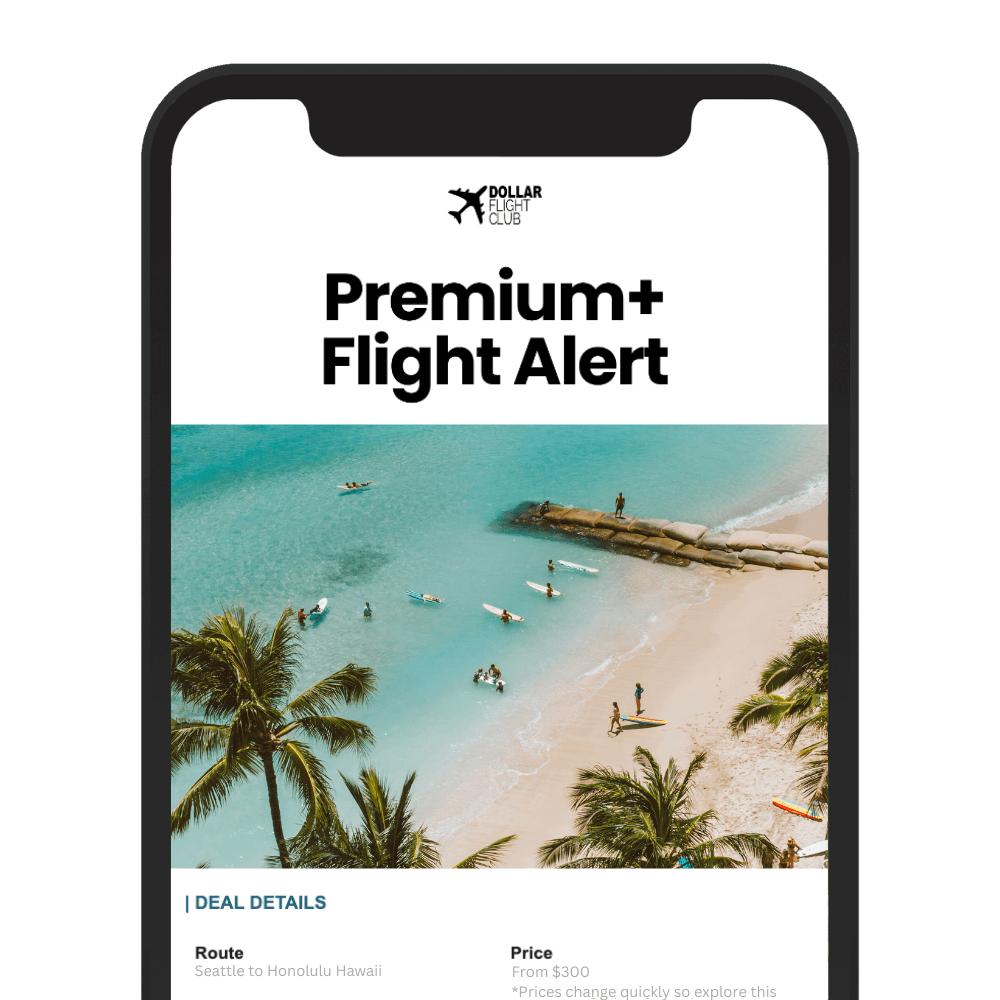Want to save hundreds on flights without constantly checking prices? Fare alerts do the work for you by tracking airfare trends and notifying you when prices drop. Here’s what you need to know:
- What are fare alerts? Tools that monitor flight prices based on your preferences (routes, dates, airlines) and notify you of deals via email, text, or app notifications.
- Why use them? Save time and money. Travelers saved an average of $297 per trip in 2024.
- How to set them up? Use platforms like Google Flights, Hopper, or Dollar Flight Club to track prices, customize notifications, and get real-time updates.
- Pro tips for bigger savings: Be flexible with travel dates, track multiple routes, and act fast when notified of deals.
Ready to save? Scroll down for step-by-step instructions for Google Flights, Hopper, and Dollar Flight Club.
What Are Fare Alerts and Why Use Them?
Fare alerts are like having a personal assistant for flight price monitoring, working around the clock to help you save money. Airfares can change multiple times a day, making it nearly impossible to keep up manually. Fare alerts solve this problem by tracking prices continuously, so you don’t have to keep refreshing websites.
How Fare Alerts Work
Fare alerts are designed to track flight prices based on the criteria you set. You can tailor your preferences to specific routes, travel dates, and airlines. Some services even let you track flexible dates or open-ended destinations, which is especially handy if your travel plans aren’t set in stone. Advanced systems go a step further by analyzing historical pricing data to predict whether fares will rise or fall. This predictive insight can help you decide the best time to book.
The technology works in real time, scanning for price changes. When a fare drops significantly – or sometimes even with minor changes – you’ll get a notification so you can act quickly.
Types of Notifications
Fare alerts can reach you in several ways, and mobile apps tend to be the most effective. In fact, mobile app notifications are 22% better at catching deals compared to desktop alerts. You can choose to receive updates via email, SMS, or push notifications directly to your phone.
Interestingly, inbox messages in mobile apps boast higher open rates (over 22%) compared to push notifications, which only see about a 5% open rate. This makes app inboxes a more reliable way to ensure you don’t miss a deal.
Many platforms also let you customize how often you’re notified and set thresholds for price drops. This way, you avoid being bombarded with alerts while still catching the savings that matter most.
Key Benefits of Fare Alerts
The financial perks of fare alerts are hard to ignore. In 2024, travelers who used these tools saved an average of $297 per trip. For international flights, the savings were even more impressive, with real-time tracking leading to a 37% reduction in costs.
But it’s not just about saving money. Fare alerts also save you time and effort. Instead of constantly checking multiple sites, you can set up alerts once and let the system do the heavy lifting. On average, users who relied on price alerts booked 31 days earlier than those who didn’t, unlocking even more savings. Early notifications not only help with planning but also increase your chances of snagging the best deals.
Fare alerts also give you a better understanding of pricing trends. For instance, if you notice prices consistently climbing in your alerts, you’ll know it’s time to book before they rise further. With these tools, you’re not just saving money – you’re making smarter, more informed travel decisions.

How to Set Up Fare Alerts Step-by-Step
Setting up fare alerts is a breeze. While the exact steps depend on the platform, the process is simple and quick. Here’s how to get started on some popular tools.
Using Google Flights
Google Flights is a great option for tracking fares, especially if you already know your travel dates and destination. Start by signing into your Google account to save your preferences and receive notifications via Gmail. Then, head over to Google Flights and fill in your departure city, destination, travel dates, and the number of travelers.
Once the search results appear, refine your options using filters. You can adjust for your preferred travel class, opt for direct flights, select specific airlines, or even narrow down departure and arrival times. After tailoring your search, toggle the “Track Prices” option. Google Flights will monitor the fares for your selected route or flights with flexible dates and notify you via email whenever there’s a significant price change.
To keep an eye on trends, check the “Tracked flight prices” section in your Google account. You can also use tools like the Price Graph and Date Grid to get a visual understanding of fare fluctuations.
Setting Up Alerts on Hopper
Hopper is designed for mobile users and makes fare tracking super convenient. Start by downloading the Hopper app from your device’s app store and creating an account. Enter your travel details and tap “Watch This Trip” to begin tracking.
Make sure to enable push notifications so you’ll get real-time updates directly on your phone. Hopper’s predictive analytics will even give you insights on whether it’s the right time to book or if prices are likely to drop or rise.
Setting Up Alerts on Dollar Flight Club
Dollar Flight Club specializes in finding and sending out exclusive flight deals. To get started, visit dollarflightclub.com and sign up for an account. Choose the plan that fits your needs: the free Basic plan offers 1–3 weekly domestic economy deals from one departure airport, while Premium plans provide daily deals, international options, and personalized alerts for multiple departure airports and dream destinations.
After setting up your account, select your departure airport and, if you’re on a Premium plan, add dream destinations to tailor your alerts. Basic members receive email notifications, while Premium+ subscribers can also opt for SMS alerts to stay updated on time-sensitive deals.
Dollar Flight Club’s team actively searches for mistake fares and discounted flights, so you might even get alerts for destinations you hadn’t considered. When you receive an alert, act fast – these deals are often limited and don’t last long.
How to Get More Value from Fare Alerts
Once you’ve set up your fare alerts, the real savings come from using smart strategies. By setting up multiple alerts, staying flexible, and acting quickly when a deal pops up, you can make the most of these tools.
Tracking Multiple Routes
Keeping an eye on several routes can significantly increase your chances of finding a good deal. Instead of focusing on just one airport or destination, expand your search. For instance, if you’re based in New York, include alerts for JFK, LaGuardia, and Newark. If you’re open to traveling a bit further, you could even add airports in nearby cities. The same applies to international trips – monitoring flights to multiple cities may uncover cheaper options.
Another tip? Set up alerts for both round-trip and one-way flights. Sometimes booking two one-way tickets ends up being cheaper than a traditional round-trip fare.
And don’t stop there – flexibility with dates and destinations can lead to even better deals.
Being Flexible for Better Deals
Flexibility is your best friend when it comes to finding affordable flights. Adjusting your travel dates, destinations, or even the day of the week you fly can save you a lot. This approach works. For example, flights to Europe in late August instead of mid-summer can save you around $300, while trips to Asia could cost $500 less. Being open to flying on less popular days – like Tuesdays, Wednesdays, and Saturdays – can also help, as these are often the cheapest days to fly.
Timing your booking is just as important. Data from Google Flights reveals that domestic tickets are usually cheapest when purchased 21 to 60 days before departure, with the sweet spot around 44 days out. For European destinations, booking 50 to 179 days in advance often yields the best rates. If you’re heading to Mexico or the Caribbean, aim to book 37 to 87 days ahead. And while nonstop flights are convenient, choosing options with layovers can sometimes lead to significant savings.
Once you spot a deal, though, speed is everything.
Acting Fast on Deals
When your fare alerts notify you of a great deal, don’t wait – act fast. Flight prices can change in a matter of hours. In fact, fares might drop by as much as 40% briefly, only to jump back up by $500 for international round-trips within a week. To stay ahead, some experts recommend checking for deals on Tuesday mornings when airlines often release new promotions.
Even after you’ve booked, it pays to keep watching. Many airlines now offer fee-free changes, so if prices drop further, you might be able to rebook at a lower rate. Quick action, combined with a bit of persistence, can make a big difference in how much you save.

Managing and Customizing Fare Alerts
Fine-tune your fare alerts to stay informed about the best deals without being overwhelmed.
Customizing Notification Settings
How you set up your notifications can make all the difference in catching those price drops without drowning in updates. Most platforms let you choose how you want to be notified – via email, SMS, or push notifications from their mobile apps. The trick is to strike a balance between staying on top of deals and avoiding constant interruptions.
Emails are great for detailed updates, while push notifications are quicker for time-sensitive deals. If you’re using a mobile app, double-check that push notifications are enabled in your settings so you don’t miss out on flash sales or limited-time offers.
Take advantage of your platform’s watchlist to manage active alerts and tweak how often you get updates. This feature is especially handy if you’re tracking multiple routes and don’t want to be flooded with notifications. Many platforms offer options like immediate alerts for every price change, daily summaries, or even weekly roundups.
For example, Google Flights sends email updates when prices change significantly, but users have reported occasional issues with email delivery. To manage these alerts, click “Add notification” on a tracked flight to enable or disable email updates. Since email reliability can vary, it’s a good idea to regularly check your tracked flights directly on the platform.
For more accurate tracking, set specific travel dates as soon as you know them. You can also opt for flexible date ranges if you’re open to catching a broader range of deals. Some platforms even allow you to customize alerts based on preferred airlines or alliances.
Once you’ve tailored your alerts, you might want to know how to pause them when needed.
Pausing or Turning Off Alerts
Sometimes, you’ll need a break from the constant updates – maybe you’ve already booked your trip or just need some peace from the notifications. Most platforms make it easy to pause alerts without losing your settings. For instance, Google Flights lets you manage this in the Tracked Flights section. You can turn off email notifications for specific routes while keeping the tracking active or completely stop tracking by selecting “Remove”.
Other platforms offer similar options, often labeled as “pause alerts”, “disable notifications”, or “snooze.” These features are especially helpful during busy times when you’re not ready to act on deals but don’t want to lose your carefully configured settings.
When you’re ready to dive back in, reviewing price history can help you make smarter booking choices.
Checking Price History
Customizing alerts is just one part of the equation – understanding price trends can give you an edge when deciding when to book. Many fare alert platforms offer price history tools that show how fares have changed over time. These charts often reveal patterns, like whether prices are steadily dropping or starting to climb. If fares are trending downward, it might be worth waiting. But if prices are rising, it could be time to lock in your booking.

Conclusion
By following the step-by-step setup outlined earlier, you can turn these tools into real savings. To make the most of them, try to keep your travel dates flexible, monitor flights from multiple nearby airports, and act fast when a good deal pops up.
Setting up alerts early gives you the best shot at snagging price drops before they’re gone. Acting quickly can result in major savings, with travelers often landing fares well below the usual rates. In fact, scoring just one fantastic deal can easily offset the cost of premium alert services.
One standout tool in this space is Dollar Flight Club, which offers personalized alerts that help you save even more. With over 3 million members collectively saving an estimated $10 million in 2024, the platform specializes in uncovering deals that are 60% to 90% cheaper than average round-trip prices. Their updated algorithm tailors deals to match members’ dream destinations, making the alerts even more useful.
“Our members trust us to find them the best flight deals, and now we’re going even further by making those deals more personalized and relevant”.
Founder Jesse Neugarten emphasizes the importance of this personalization. Coupled with timely SMS notifications for mistake fares and flash sales, Dollar Flight Club ensures you never miss an opportunity to save big.
FAQs
How can fare alerts help me save more on international flights than domestic ones?
Fare alerts can be a game-changer when it comes to saving money on international flights. These fares tend to vary quite a bit over time, often dropping between 2–8 months before your trip and spiking as the departure date gets closer. With alerts in place, you can keep an eye on these shifts and snag a ticket when prices hit their lowest point.
Another advantage of international flights is their longer booking window, giving you more chances to catch a price drop. This makes fare alerts especially helpful for international travel, where the savings can be much greater compared to domestic flights, which usually see smaller and quicker price changes.
What should I do if I get multiple fare alerts but I’m not ready to book?
If you’re getting a flood of fare alerts but aren’t quite ready to commit to booking, take some time to monitor prices over a period. Many tools and websites let you track fare changes, helping you spot patterns and book when the price seems right.
Feeling bogged down by constant notifications? You can always pause or tweak your alerts. This keeps you in the loop without overwhelming your inbox, and you can turn them back on when you’re set to finalize your travel plans.
Can I set up fare alerts for specific airlines or flight preferences, like non-stop flights?
Yes, you can tailor fare alerts to fit your travel needs. Most platforms let you set filters for things like preferred airlines, flight types (non-stop or with layovers), and even the length of the flight. This way, you’ll only get notified about flights that align with your preferences, making it easier to focus on the options that suit your plans.










